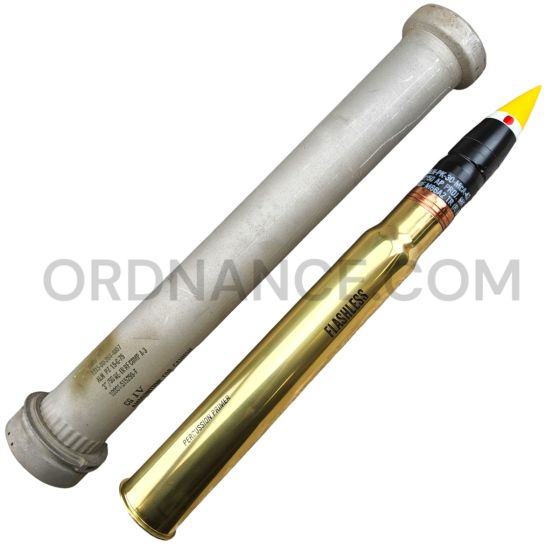Inert 3-inch .50 cal Mark 29 Armor-Piercing Capped Round with Brass Cartridge Case
The 3-inch .50 caliber gun (spoken "three-inch-fifty-caliber") in United States naval gun terminology indicates the gun fired a projectile 3 inches (76mm) in diameter, and the barrel was 50 calibers long (barrel length is 3 in × 50 = 150 in or 3.8 m). Different guns (identified by Mark numbers) of this caliber were used by the U.S. Navy and U.S. Coast Guard from 1890 through the 1990s on a variety of combatant and transport ship classes.
The US Navy's first 3-inch .50 cal gun (Mark 2) was an early model with a projectile velocity of 2,100 feet (640 m) per second. Low-angle mountings for this gun had a range of 7000 yards at the maximum elevation of 15 degrees. The gun entered service around 1902 with the Bainbridge-class destroyers and was also fitted to Connecticut-class battleships. By World War II, these guns had been found only on a few Coast Guard cutters and defensively equipped merchant ships. Low-angle 3?/50 caliber guns (Marks 3, 5, 6, and 19) were originally mounted on ships built from the early 1900s through the early 1920s and were carried by submarines, auxiliaries, and merchant ships during the Second World War. These guns fired the same 2,700 feet (820 m) per second ammunition used by the following dual-purpose Marks but with range limited by the maximum elevation of the mounting. These were built-up guns with a tube, partial-length jacket, hoop, and vertical sliding breech block.
Dual-purpose 3-inch .50 cal guns (Marks 10, 17, 18, and 20) first entered service in 1916 as a refit to USS Texas (BB-35) and were subsequently mounted on many types of ships as the need for anti-aircraft protection was recognized. During World War II, they were the primary gun armament on destroyer escorts, patrol frigates, submarine chasers, minesweepers, some fleet submarines, and other auxiliary vessels, and were a secondary dual-purpose gun on some other types of ships, including some older battleships. They also replaced the original low-angle 4-inch .50 caliber guns (Mark 9) on "flush-deck" Wickes and Clemson-class destroyers to provide better anti-aircraft protection. The AVD seaplane tender conversions received two guns; the APD transport, DM minelayer, and DMS minesweeper conversions received three guns, and those retaining destroyer classification received 6. These guns used fixed ammunition (case and projectile handled a single assembled unit) weighing 34 pounds. Projectiles weighed about 13 pounds, including a burster charge of 0.81 pounds for anti-aircraft (AA) rounds and 1.27 pounds for high capacity (HC) rounds. The maximum range was 14,600 yards at 45 degrees elevation, and the ceiling was 29,800 feet (9,100 m) at 85 degrees elevation. Useful life expectancy was 4300 effective full charges (EFC) per barrel. The 3-inch .50 cal gun (Mark 22) was a semiautomatic anti-aircraft weapon with a power-driven automatic loader. The United States Navy considered contemporary 5-inch .38 caliber guns and 5-inch .54 caliber guns more effective against surface targets. These monobloc 3? guns were fitted to both single and twin mountings. The single was to be exchanged for a twin 40mm antiaircraft gun mount and the twin for a quadruple 40mm mount. This was performed on Essex-class aircraft carriers, Sumner- and Gearing-class destroyers, and other ships circa 1946-50.
Although intended as a one-for-one replacement for the 40 mm mounts, the final version of the new 3-inch (76mm) mounts was heavier than expected, and on most ships, the mounts could be replaced only on a two-for-three basis. The mounts were of the dual-purpose, open-base-ring type. The right and left gun assemblies were identical in the twin mounts. The mounts used a common power drive that could train at a rate of 30 degrees/second and elevate from 15 degrees to 85 degrees at a rate of 24 degrees/second. The cannon was fed automatically from an on-mount magazine which was replenished during action by two loaders on each side of the cannon. With proximity fuze and fire-control radar, a dual 3-inch .50 cal mount firing 50 rounds per minute per barrel was considered more effective than a quad Bofors 40mm gun against subsonic aircraft but relatively ineffective against supersonic jets and cruise missiles. Destroyers that were modernized during the Fleet Rehabilitation and Modernization (FRAM) program of the 1960s had their 3-inch (76mm) guns removed, but others retained them. In 1992, the USCGC Storis 3-inch .50 cal0 caliber main battery was removed from the cutter. This was supposedly the last 3-inch .50 cal gun in service aboard any US warship, but US Navy Charleston-class amphibious cargo ships still retained their forward mounts until the last of the ships, USS El Paso (LKA-117) was decommissioned in 1994. The gun is still in service, however, on some warships of the Philippine Navy, including BRP Rajah Humabon, formerly USS Atherton. The 17 Asheville-class gunboats mounted a single 3-inch .50 cal Mk 34 as their primary armament.
Approx length ", Approx width ", Approx height 37", Approx weight 21lbs.
Pictures are stock images of our inventory. Unless otherwise noted, you will not be receiving the exact item shown in the pictures. The pictures are representative of the item's general condition. The item you receive might be slightly better, or worse, condition than was shown in the pictures.
Please visit our page about order lead times here: Order Lead Times

